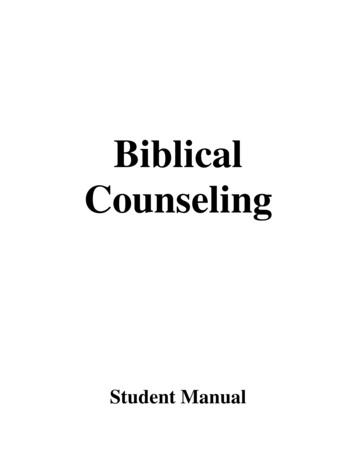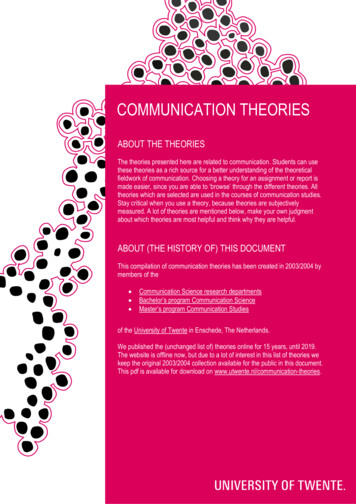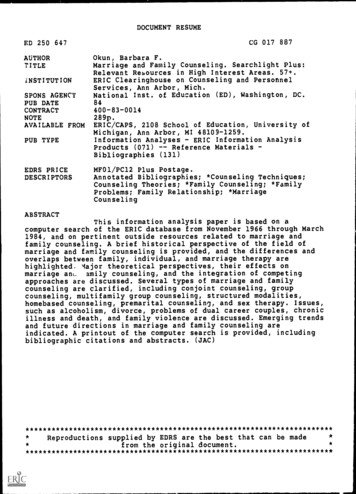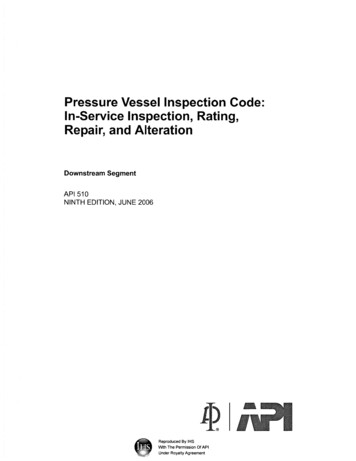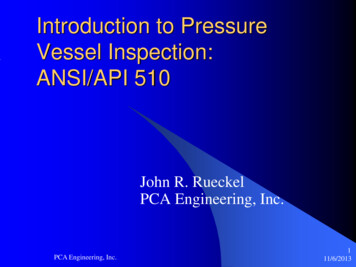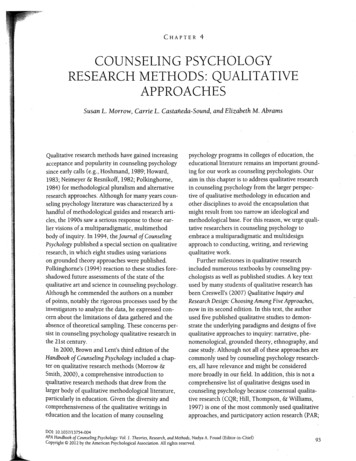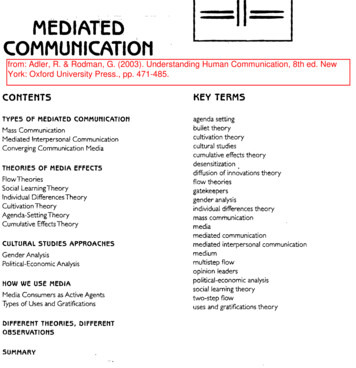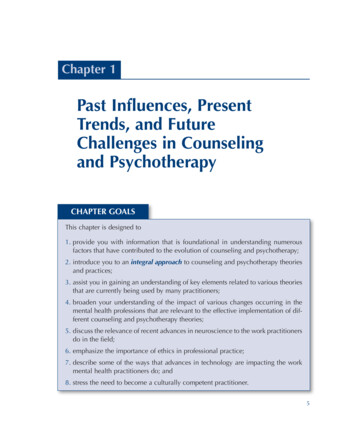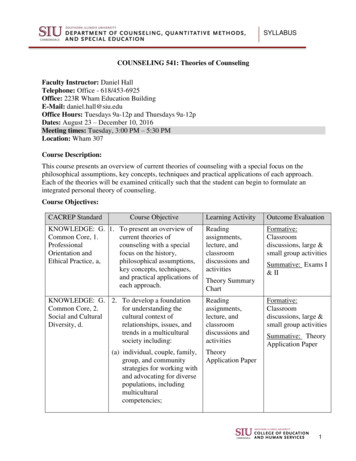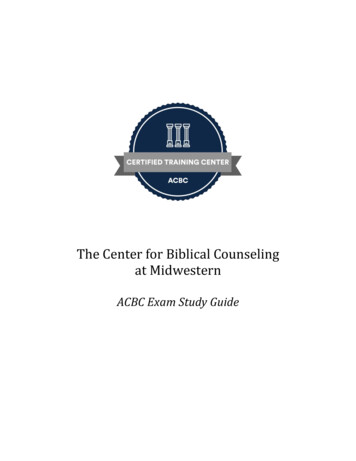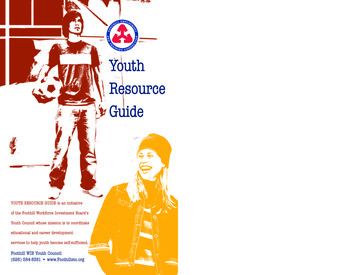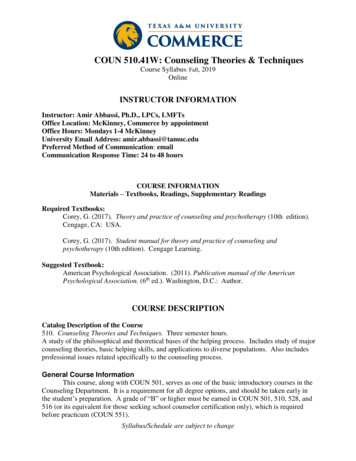
Transcription
COUN 510.41W: Counseling Theories & TechniquesCourse Syllabus: Fall, 2019OnlineINSTRUCTOR INFORMATIONInstructor: Amir Abbassi, Ph.D., LPCs, LMFTsOffice Location: McKinney, Commerce by appointmentOffice Hours: Mondays 1-4 McKinneyUniversity Email Address: amir.abbassi@tamuc.eduPreferred Method of Communication: emailCommunication Response Time: 24 to 48 hoursCOURSE INFORMATIONMaterials – Textbooks, Readings, Supplementary ReadingsRequired Textbooks:Corey, G. (2017). Theory and practice of counseling and psychotherapy (10th edition).Cengage, CA: USA.Corey, G. (2017). Student manual for theory and practice of counseling andpsychotherapy (10th edition). Cengage Learning.Suggested Textbook:American Psychological Association. (2011). Publication manual of the AmericanPsychological Association. (6th ed.). Washington, D.C.: Author.COURSE DESCRIPTIONCatalog Description of the Course510. Counseling Theories and Techniques. Three semester hours.A study of the philosophical and theoretical bases of the helping process. Includes study of majorcounseling theories, basic helping skills, and applications to diverse populations. Also includesprofessional issues related specifically to the counseling process.General Course InformationThis course, along with COUN 501, serves as one of the basic introductory courses in theCounseling Department. It is a requirement for all degree options, and should be taken early inthe student’s preparation. A grade of “B” or higher must be earned in COUN 501, 510, 528, and516 (or its equivalent for those seeking school counselor certification only), which is requiredbefore practicum (COUN 551).Syllabus/Schedule are subject to change
Student Learning Outcomes2009 CACREP Standards Addressed in COUN 510CMHC StandardA.5. Understands a variety ofmodels and theories related toclinical mental healthcounseling, including themethods, models, and principlesof clinical supervisionE.3. Understands currentliterature that outlines theories,approaches, strategies, andtechniques shown to be effectivewhen working with specificpopulations of clients withmental and emotional disordersI.3. Knows evidence-basedtreatments and basic strategiesfor evaluating counselingoutcomes in clinical mentalhealth counselingCore Standard2.G.2.c. Theories ofmulticultural counseling,identity development, and socialjustice2.G.5.d. Counseling theories thatprovide the student with modelsto conceptualize clientpresentation and that help thestudent select appropriatecounseling interventions.Students will be exposed tomodels of counseling that areconsistent with currentprofessional research andpractice in the field so theybegin to develop a personalmodel of counseling2.G.5.e. A systems perspectiveLearning Activity orAssignmentReading Chapters in the 1-15(Corey 2017): KeyAssessment 19:Final ExamAssessmentKey Assessment 19:Final Exam Rubricmultiple choice exam overthe text bookReading Assignment overchapter 3 of the Corey 2017Supplemental readingassignmentLearning Activity orAssignmentWriting Chapter reviews onMulticultural considerationfor each theory discussedReading weekly assignmentson new theory of counselingReading Chapter 14 of theExam 1 over assignedreadingExam Rubric and ThreadedAssessmentExam Rubric and ThreadedWriting a chapter review oneach theory3 separate Exams on theassigned chaptersCompare and Contrast APAfinal paperWriting chapter review andSyllabus/Schedule are subject to change
that provides an understandingof family and other systemstheories and major models offamily and related interventionsCorey 2017Exam 2 over assignedreadingCourse Objectives include, but are not limited to, the following:1. The student will identify, explain, and/or describe generally accepted characteristics ofeffective helpers.2. Students will differentiate counseling from traditional interpretations of guidance,psychotherapy, and consultation via explanation, description, or the identification ofdescriptive statements.3. Students will distinguish between the outcome and process goals of counseling andconsultation via explanation, description, or the identification of descriptive statements.4. Students will identify, generate responses, and/or demonstrate appropriate behaviors whichare consistent with the Ethical Standards and Standards of Practice of the AmericanCounseling Association, including differentiating between ethical and legal issues.5. Students will identify, explain, and/or describe characteristics and behaviors that influencehelping processes, including, but not limited to age, gender, ethnicity, culture, race, lifestyle,verbal and nonverbal communication styles, personal characteristics, traits, capabilities andlife circumstances.6. Students will identify, describe, and/or apply appropriate counseling skills toclient/consultees who are different from the counselor in terms of race, cultural background,gender, age, physical abilities, lifestyle, and/or other criteria.7. Students will identify, describe, and/or apply appropriate counseling skills to clients who arereluctant or resistant.8. Students will identify, describe, and/or apply appropriate counseling skills to clients who aresuicidal.9. Students will identify and/or list and describe the typical stages of counseling initialinterview through termination.10. Students will identify, explain, apply, and/or evaluate hypothetical examples of basiclistening, empathy, genuineness, unconditional positive regard, concreteness, immediacy,confrontation, self-disclosure, structuring, use of silence, nonverbal communication, andcommunication leads such as interpretation, probes, reassurances, questions, andrestatements and reflections.11. Students will identify, explain, or demonstrate behaviors congruent with currently accepted,psychodynamic, cognitive-behavioral and affective counseling theories, techniques, andpractices, including, but not limited to Psychoanalytic, Adlerian, Existential, Personcentered, Gestalt, Behavioral, Cognitive-behavioral, Reality, Family systems, and Solutionfocused.TExES COMPETENCIESCompetency 004 (Program Management)Syllabus/Schedule are subject to change
The school counselor understands how to plan, implement and evaluate a developmentalguidance program, including counseling services, that promotes all students’ successCompetency 006 (Counseling)The school counselor understands how to provide effective counseling services to individualsand small groups.Competency 010 (Professionalism)The school counselor understands and complies with ethical, legal, and professional standardsrelevant to the profession.COURSE REQUIREMENTSMinimal Technical Skills NeededIn this class, you will utilize the Learning Management System (LMS) entitled D2L for portionsof instructional and learning methods, submitting assignments, participating in onlinediscussions, and completing quizzes. You will need to utilize other technologies such asMicrosoft Word, PowerPoint, etc. If you have issues with this system, it is your responsibility tocontact the help desk immediately.Instructional MethodsThis course consists of lecture and didactic learning methods, small group discussions, and inclass assignments, coupled with experiential learning and practical application. When we are notmeeting face to face, you will be expected to participate and complete all online tasks via D2L Inaddition to this, small lecture, discussion, activities, and workshops may be utilized during thiscourse.Student Responsibilities or Tips for Success in the CourseAs a student in this course, you are responsible for the active learning process. Expectations ofthis course include the following:1. You are expected to display professionalism at all times. Be respectful of your professorand peers. Be open to feedback, as you will receive this throughout the program.2. Prepare for classes. Complete any and all readings prior to class time.3. Complete all assignments by the deadline.4. Adhere to the university student code of conduct.5. Participate. During face-to-face classes, you are expected to actively participate in allactivities and discussion. In the online format, you are expected to participate in all onlinediscussions/activities. This is crucial to your learning.6. All writing assignments must be done according to APA 6th edition.7. Regularly check your University email. My suggestion is to check this at least once a dayas your instructors and others from the department and University may contact you.8. Begin your readings ASAP. Sometimes it may take more than one attempt to digest thematerial.Syllabus/Schedule are subject to change
9. Deadlines are the last possible moment something is due—not the first moment to start.Work ahead. I realize this may not always be possible; however, when you can, do so.10. Be open to the process. This degree takes time, work, effort, and growth.Assignments/Assessments:1. Theory/Chapter Reviews (20 points): Using the structure in Appendix A, students willbe required to complete a theory review on each theory prior to covering the theory(please see course calendar in this syllabus for more info.) . This review needs to bedropped to the appropriate Drop Box for the week on the D2L by midnight on the daythat is due in order to receive the two-point credit. Please see the tentative courseCalendar for the due dates. Please note that I will give no credit to those theory reviewswhich are uploaded after the due date. You will do a total of 11 theory reviews for a totalof 20 points. I will drop the lowest mark on one theory. That means you get to drop thelowest mark or skip a theory review and still receive the full 20 % credit. All your reviewmust be uploaded in Microsoft Word format (MSWord). If you do not have the softwareon your computer, you need to obtain a copy of it.2.Theory/Chapter Reviews Rubric1 – Does Not Meet2 – Meets3 – ExceedsExpectationExpectationExpectation(0-.9 points)( 1-1.4points)(1.5-2.0 points)Compare and contrast Did not selectTheories wereAll basic concepts aretwo original theories theories from the list selected from the one covered. In depthfrom the one studiedof those that wethat was discussed in review of relatedin this classstudied in this class.class, most basicconcepts. evidence of2 pointsMissed basic concept concepts are covered, possessingconcepts. Writing isevidence ofknowledge aboutshallow and no inpossessingtopic without missingdepth exploration ofknowledge about the key information;theories. no evidence theories but missingrepresentative ofof synthetizationone or two keygraduate level workacross multiplepoints; representativesources; notof graduate levelrepresentative ofworkgraduate level work1.Key Assessment 19: Final Exam (20 points): There will be a Final multiple-choiceexams. The exams will cover your readings and lecture material. The exams will beonline and timed. If you think you are going to have problem with taking a time limitedexam online, you may want to switched this from an online class to regular 510. Areview of the exam will be provided two weeks prior. The goal of the exam is to test yourknowledge on various concepts of the main theories of counseling that we study in thisclass, as well as apply that knowledge to practice. There will be no make up test on anySyllabus/Schedule are subject to change
of the exams.Key Assessment 19: Final Exam Rubric1 – Does Not MeetExpectation(0-39 points)Grade Percentageon ExamLess than 80% correcton all exam items2 – Meets Expectation(40-44 points)Between 80% and89% correct on allexam items3 – ExceedsExpectation(45-50 points)Greater than 89%correct on all examitems2. Comparison Research Paper: Choose two theories of most interest to you from the listof theories studied during this class. Using your Text book and 4 original sources foreach of the theory, write a compare/contrast paper. Topics to compare and contrastshould include the following: nature of person, personality development, emotionalmaladjustment, counselor/client relationship, techniques, therapeutic goals, Multiculturalconsideration and treatment outcome (see Appendix A). Research paper must followAmerican Psychological Association (APA) guidelines (see Appendix B) and should notexceed 12 pages (including cover and reference page, no Abstract is necessary). You willbe graded according to APA style, writing and organization, content, and references.Original source is defined as journal article or book authored or co-authored by a majorcontributor of that particular theory. This research paper needs to be dropped in theappropriate drop box on the D2L by the due date at the end of the semester in order toreceive credit. This paper needs to be in the MSWord format as well.Comparison Research Paper Rubric1 – Does Not Meet2 – MeetsExpectationExpectation(0-39 points)(40-44 points)Compare and contrast Did not selectTheories weretwo original theories theories from the list selected from the onefrom the one studiedof those that wethat was discussed inin this classstudied in this class.class, most basic50 pointsMissed basic concept concepts are covered,concepts. Writing isevidence ofshallow and no inpossessingdepth exploration ofknowledge about thetheories. no evidence theories but missingof synthetizationone or two keyacross multiplepoints; representativeSyllabus/Schedule are subject to change3 – ExceedsExpectation(45-50 points)All basic concepts arecovered. In depthreview of relatedconcepts. evidence ofpossessingknowledge abouttopic without missingkey information;representative ofgraduate level work
sources; notrepresentative ofgraduate level workDid not follow APAformat in cover page,body of the paper andthe reference page.Did not use fouroriginal sources foreach theory selected.Sources are notrelated to the topic ofpaperAPA formatReference page50 pointsof graduate levelworkAPA format wasfollowed with one ortwo minor errors.Mostly originalsources were used.Sources are related tothe selected theoriesAPA format wasfollowed with noerrors on cover page,in body of the paperor reference page.All four originalsources were used3. Exams (20 points each) There will be two multiple choice and True/False timed examsduring the semester (see course calendar). A review of the exams will be providedonline. The goals of the exams are to test your knowledge on various theories ofpsychotherapy covered in this course, as well as apply that knowledge to practice.1 – Does Not MeetExpectationGrade on test2 – Meets ExpectationLess than 80% correcton all exam itemsBetween 80% and89% correct on allexam itemsGRADINGFinal grades in this course will be based on the following scale:90%-100%80%-89%70%-79%60%-69% 59%ABCDFAssignment/Assessment3 Exams (20 points each)Point Value60Professional Paper20Theory Review Paper20Syllabus/Schedule are subject to change3 – ExceedsExpectationGreater than 89%correct on all examitems
Total100Grading: An instructor does not give grades. Students earn grades. If you approach yourclass with this understanding, it is the beginning of taking responsibility for your education andbeing a great student.TECHNOLOGY REQUIREMENTSBrowser supportD2L is committed to performing key application testing when new browser versions are released.New and updated functionality is also tested against the latest version of supported browsers.However, due to the frequency of some browser releases, D2L cannot guarantee thateach browser version will perform as expected. If you encounter any issues with any ofthe browser versions listed in the tables below, contact D2L Support, who will determine the bestcourse of action for resolution. Reported issues are prioritized by supported browsers and thenmaintenance browsers.Supported browsers are the latest or most recent browser versions that are tested against newversions of D2L products. Customers can report problems and receive support for issues. For anoptimal experience, D2L recommends using supported browsers with D2L products.Maintenance browsers are older browser versions that are not tested extensively against newversions of D2L products. Customers can still report problems and receive support for criticalissues; however, D2L does not guarantee all issues will be addressed. Amaintenance browser becomes officially unsupported after one year.Note the following: Ensure that your browser has JavaScript and Cookies enabled.For desktop systems, you must have Adobe Flash Player 10.1 or greater.The Bright space Support features are now optimized for production environments whenusing the Google Chrome browser, Apple Safari browser, Microsoft Edge browser,Microsoft Internet Explorer browser, and Mozilla Firefox browsers.Desktop SupportBrowserSupported Browser Version(s) Maintenance Browser Version(s)Microsoft EdgeLatestN/AMicrosoft InternetExplorer N/A11Syllabus/Schedule are subject to change
BrowserSupported Browser Version(s) Maintenance Browser Version(s)Mozilla Firefox Latest, ESRN/AGoogle Chrome LatestN/AApple Safari LatestN/ATablet and Mobile SupportDeviceOperating SystemBrowserSupported Browser Version(s)Android Android 4.4 ChromeLatestAppleiOS Safari,ChromeThe current major version of iOS(the latest minor or point release ofthat major version) and theprevious major version of iOS (thelatest minor or point release of thatmajor version). For example, as ofJune 7, 2017, D2Lsupports iOS10.3.2 and iOS 9.3.5, but not iOS10.2.1, 9.0.2, or any other version.Chrome: Latest version for theiOS browser.WindowsWindows 10Edge,Chrome,FirefoxLatest of all browsers, and FirefoxESR. You will need regular access to a computer with a broadband Internet connection. Theminimum computer requirements are:o 512 MB of RAM, 1 GB or more preferredo Broadband connection required courses are heavily video intensiveo Video display capable of high-color 16-bit display 1024 x 768 or higherresolution For YouSeeU Sync Meeting sessions 8 Mbps is required. Additional system requirementsfound here: 07031107-Basic-SystemRequirements You must have a:Syllabus/Schedule are subject to change
o Sound card, which is usually integrated into your desktop or laptop computero Speakers or headphones.o *For courses utilizing video-conferencing tools and/or an online proctoringsolution, a webcam and microphone are required. Both versions of Java (32 bit and 64 bit) must be installed and up to date on your machine. Ata minimum Java 7, update 51, is required to support the learning management system. Themost current version of Java can be downloaded at: JAVA web sitehttp://www.java.com/en/download/manual.jsp Current anti-virus software must be installed and kept up to date.Running the browser check will ensure your internet browser is supported.Pop-ups are allowed.JavaScript is enabled.Cookies are enabled. You will need some additional free software (plug-ins) for enhanced web browsing. Ensurethat you download the free versions of the following software:o Adobe Reader https://get.adobe.com/reader/o Adobe Flash Player (version 17 or later) https://get.adobe.com/flashplayer/o Adobe Shockwave Player https://get.adobe.com/shockwave/o Apple Quick Time http://www.apple.com/quicktime/download/ At a minimum, you must have Microsoft Office 2013, 2010, 2007 or Open Office. MicrosoftOffice is the standard office productivity software utilized by faculty, students, and staff.Microsoft Word is the standard word processing software, Microsoft Excel is the standardspreadsheet software, and Microsoft PowerPoint is the standard presentation software.Copying and pasting, along with attaching/uploading documents for assignment submission,will also be required. If you do not have Microsoft Office, you can check with the bookstoreto see if they have any student copies.ACCESS AND NAVIGATIONYou will need your campus-wide ID (CWID) and password to log into the course. If you do notknow your CWID or have forgotten your password, contact the Center for IT Excellence (CITE)at 903.468.6000 or helpdesk@tamuc.edu.Note: Personal computer and internet connection problems do not excuse the requirement tocomplete all course work in a timely and satisfactory manner. Each student needs to have abackup method to deal with these inevitable problems. These methods might include theavailability of a backup PC at home or work, the temporary use of a computer at a friend's home,the local library, office service companies, Starbucks, a TAMUC campus open computer lab, etc.Syllabus/Schedule are subject to change
COMMUNICATION AND SUPPORTBrightspace SupportNeed Help?Student SupportIf you have any questions or are having difficulties with the course material, please contactyour Instructor.Technical SupportIf you are having technical difficulty with any part of Brightspace,please contact Brightspace Technical Support at 1-877-325-7778 or clickon the Live Chat or click on the words “click here” to submit an issuevia email.System MaintenancePlease note that on the 4th Sunday of each month there will be System Maintenance whichmeans the system will not be available 12 pm-6 am CST.Interaction with Instructor StatementCommunication with your professors is key to your professional growth. I am here to supportand guide you along your academic journey. With that being said, I cannot help you if you do notcommunicate with me. Please make an appointment if you have any concerns or questions.Because I teach in different locations, email is the best way to reach me. I will attempt to answerall emails within 24 hours, Monday-Friday, but at times will need up to 72 hours to do so. Whenemailing, please use your university email and address me with courtesy and respect.COURSE AND UNIVERSITY PROCEDURES/POLICIESCourse Specific Procedures/PoliciesWritten assignments are due on the day noted in the syllabus. All papers are due at the beginningof the class period. Late papers will have 10% deduction per day late from the final score.Syllabus Change PolicyThe syllabus is a guide. Circumstances and events, such as student progress, may make itnecessary for the instructor to modify the syllabus during the semester. Any changes made to thesyllabus will be announced in advance.Syllabus/Schedule are subject to change
COURSE AND UNIVERSITY PROCEDURES/POLICIESSyllabus Change PolicyThe syllabus is a guide. Circumstances and events, such as student progress, may make itnecessary for the instructor to modify the syllabus during the semester. Any changes made to thesyllabus will be announced in advance.University Specific ProceduresStudent ConductAll students enrolled at the University shall follow the tenets of common decency and acceptablebehavior conducive to a positive learning environment. The Code of Student Conduct isdescribed in detail in the Student r/documents/studentGuidebook.pdfStudents should also consult the Rules of Netiquette for more information regarding how tointeract with students in an online forum: es.htmlTAMUC AttendanceFor more information about the attendance policy please visit the Attendance webpage andProcedure 99.R0.01.pdfAcademic IntegrityStudents at Texas A&M University-Commerce are expected to maintain high standards ofintegrity and honesty in all of their scholastic work. For more details and the definition ofacademic dishonesty see the following procedures:Undergraduate Academic Dishonesty AcademicDishonesty.pdfGraduate Student Academic Dishonesty emicDishonesty.pdfSyllabus/Schedule are subject to change
ADA StatementStudents with DisabilitiesThe Americans with Disabilities Act (ADA) is a federal anti-discrimination statute that providescomprehensive civil rights protection for persons with disabilities. Among other things, thislegislation requires that all students with disabilities be guaranteed a learning environment thatprovides for reasonable accommodation of their disabilities. If you have a disability requiring anaccommodation, please contact:Office of Student Disability Resources and ServicesTexas A&M University-CommerceGee Library- Room 132Phone (903) 886-5150 or (903) 886-5835Fax (903) 468-8148Email: Rebecca.Tuerk@tamuc.eduWebsite: Office of Student Disability Resources and rimination NoticeTexas A&M University-Commerce will comply in the classroom, and in online courses, with allfederal and state laws prohibiting discrimination and related retaliation on the basis of race,color, religion, sex, national origin, disability, age, genetic information or veteran status. Further,an environment free from discrimination on the basis of sexual orientation, gender identity, orgender expression will be maintained.Campus Concealed Carry StatementTexas Senate Bill - 11 (Government Code 411.2031, et al.) authorizes the carrying of aconcealed handgun in Texas A&M University-Commerce buildings only by persons who havebeen issued and are in possession of a Texas License to Carry a Handgun. Qualified lawenforcement officers or those who are otherwise authorized to carry a concealed handgun in theState of Texas are also permitted to do so. Pursuant to Penal Code (PC) 46.035 and A&MCommerce Rule 34.06.02.R1, license holders may not carry a concealed handgun in restrictedlocationsFor a list of locations, please refer to the Carrying Concealed Handguns On Campusdocument and/or consult your event organizer.Web loyeesAndStudents/34.06.02.R1.pdfSyllabus/Schedule are subject to change
Pursuant to PC 46.035, the open carrying of handguns is prohibited on all A&M-Commercecampuses. Report violations to the University Police Department at 903-886-5868 or 9-1-1.COURSE OUTLINE / CALENDARCourse CalendarDate08/26Week 109/02Week 309/09Week 409/16Week 5TopicCourse expectationIntroduction andoverviewThe Counselor:Person andProfessionalACA Code of EthicsReadingRead the syllabusAssignmentDiscussion post # 1Corey, ( Chapter 1)Corey, (Chapter 2)Manual (Chapter 2)Discussion post # 2Corey, (Chapter 3)ACA website:www.counseling.org09/23Week 6PsychoanalyticTherapy09/30Week 7Adlerian Therapy(Review Due)10/07Week 810/14Week 9Existential Therapy(Review Due)Person-CenteredTherapy(Review Due)Gestalt Therapy(Review Due)Corey, (Chapter 6)Manual (Chapter 6)Corey, (Chapter 7)Manual (Chapter 7)Chapter Review DueCorey, (Chapter 8)Manual (Chapter 8)Chapter Review DueBehavior Therapy(Review Due)Cognitive-BehaviorTherapyRational EmotiveBehavior Therapy(Reviews Due)Reality Therapy(Review Due)Corey, (Chapter 9)Manual (Chapter 9)Corey, (Chapter 10)Manual (Chapter 10)Chapter Review DueCorey, (Chapter 11)Manual (Chapter 11)Chapter Review Due10/21Week 1010/28Week1111/04Week 1211/11Week 13Corey, (Chapter 4)Manual (Chapter 4)Corey, (Chapter 5)Manual (Chapter 5)Syllabus/Schedule are subject to changeDiscussion post # 3Chapter Review DueChapter Review DueFIRST EXAM (chapters1-4)Chapter Review DueChapter Review DueSECOND EXAM(chapters 5-9)
11/18Week 1411/25Week 15Feminist Therapy(Review Due)Post ModernApproaches(Review Due)Corey, (Chapter 12)Manual (Chapter 12)Corey, (Chapter 13)Manual (Chapter 13)Chapter Review Due12/02Week 16Family SystemsTherapy(Review Due)Corey, (Chapter 14)Manual (Chapter 14)Chapter Review DueComparison ResearchPAPERS DUE12/09Final EXAMFinal EXAMChapter Review DueFinal EXAMAppendix ATHEORY REVIEW AND TERM PAPER WRITE-UPPoints to cover in the theory review write-up and the final position paper on a selected theory(the following points need to be included as a minimum in your final paper).1. Founder(s) of the theory.2. Nature of the person including innate capacities and/or capabilities, if any, and motivationalconstructs according to the theory.3. Nature of maladjustment (how do people develop mental illness) according to the theory.4. Goals of counseling therapy according to the theory.5. Role and activity of the counselor, including:a. major techniques used in the therapyb. diagnosis and appraisal devicesc. evaluation of client progress in therapyAppendix BAPA Pet Peevespp. 67-68, 3.08, Economy of Expressionp. 69, 3.09, Editorial “we”—“we” only refers to authors—also refers to “us,” “our,” etc.pp. 77-78, 3.18, Use the past tensepp. 79, 3.20, a pronoun must agree in numberpp. 81-82, 3.21, misplaced and dangling modifierspp. 84-86, 3.23, parallel constructionpp.73-74, 3.12, gender (use plural pronouns)p.76, 3.15, disabilities (people before disabling condition)pp. 88-89, 4.03, use a comma between elementsSyllabus/Schedule are subject to change
pp. 91-92, 4.07, quotation marks—do not hedgepp.62-63, 3.02-3.03, headingspp. 63-64, 3.04, seriationpp. 170-171, 6.03, quotation of sourcespp.111-112, 4.31 a, b, and especially 112 e—numbersp. 118, 4.45, use symbol for percent when it is preceded by a numberpp. 174-179, 6.11-6.21, Reference citations in textp. 198, 7.01, general form of citation for a periodical (examples p. 198, 7.01)Other important notes:Do not use contractionsDo not objectify people—use participants instead of subjectsDo not overuse direct quotationsAvoid secondary citationsAvoid anthropomorphismAvoid linear literature reviews (study by study)Italicize technical or key termsItalicize Likert scale descriptors—e.g. totally disagree (1) highly agree (5)For 3 to 6 authors, cite all authors first time and then use et al. e.g.—Brown et al. (1998)Numbe
Theory and practice of counseling and psychotherapy (10th edition). Cengage, CA: USA. Corey, G. (2017). Student manual for theory and practice of counseling and psychotherapy (10th edition). Cengage Learning. Suggested Textbook: American Psychological Association. (2011). Publ
